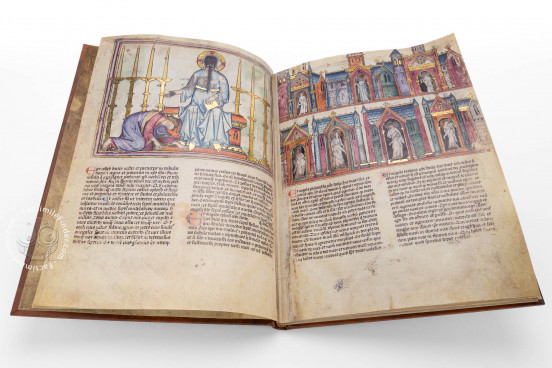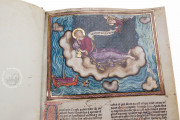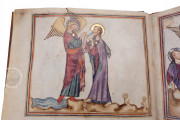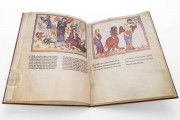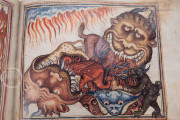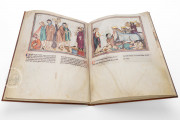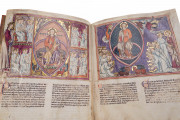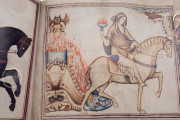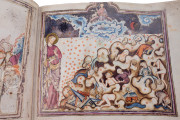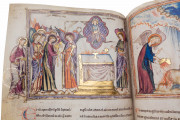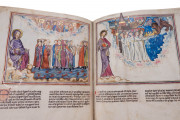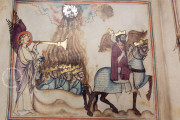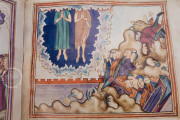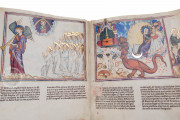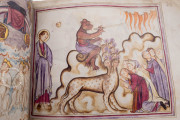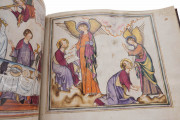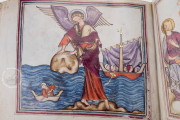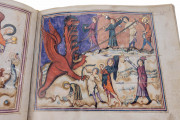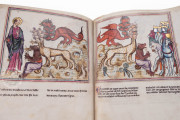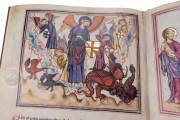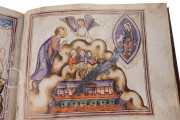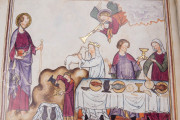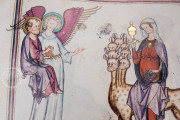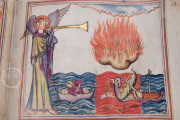The Apocalypse of Saint-Victor is a lavishly illuminated manuscript of the final book of the Christian Bible, which records Saint John the Divine's vision of the events leading to the Last Judgment. The manuscript was created in Normandy in the 1320s and draws on the pictorial treatment of John's vision developed in England in the second half of the thirteenth century. Its eighty-three miniatures visualize the various characters, including the majestic Christ of the Second Coming, and the calamitous events described in John's text.
With a miniature at the head of every page, each occupying at least half of the page, the Apocalypse of Saint-Victor is more about its paintings than its text. The episodes unfold relentlessly in brilliant color and precious metals as the viewer turns the book's pages.
Angels, Elders, and Beasts
Saint John is led by an angel through his vision, and he records the appearance of many angels. Some blow golden trumpets or pour out golden vessels that bring on natural and unnatural disasters (pp. 17-23 and 54-59).
The Elders of the Apocalypse are pictured bearded, crowned, dressed in white robes, and kneeling in adoration (p. 32). The beasts of the Apocalypse are pictured much as they are described in the text: a red dragon with seven heads and ten horns and a leopard-like beast, also with seven heads and ten horns (together on pp. 38-39).
Speech of Beasts and Angels
Many of the manuscript's miniatures show an animal or an angel swooping into the scene and "speaking" to John via words written in an elegant Gothic Textualis script on scrolls. The symbols of the four evangelists—lion, calf, man, and eagle—command that John "come and see" at the appearance of each of the horsemen of the Apocalypse (pp. 8-11).
In some scenes, an angel offers commentary on the unfolding event, as in the scene of the fall of Babylon (p. 46). The text on the angel's scroll reports "Babylon has fallen, has fallen," quoting from a prophecy of Isaiah that is repeated in the Apocalypse.
John the Observer
John is often pictured, customarily dressed in a purple tunic and blue overgarment, taking part in the events of his vision, but he is also portrayed as observing the unfolding events. In some instances, he is shown outside the miniature peering into the scene through a fictive window in the painting's frame (pp. 4, 7, 10, 11, 16, 21). John observes the Adoration of the Lamb from outside the miniature's frame but without the aid of a window (p. 15).
Puzzle Initials
The text is written in Gothic Textualis, and most sections of the text are introduced by single-color initials, red or blue, with pen flourishes in a contrasting color. Major divisions are marked by puzzle initials, letters rendered in red and blue in shapes that interlock like the pieces of a jigsaw puzzle. The most splendid of these opens the text (p. 1). All the puzzle initials are flourished in red.
One of a Group
The Apocalypse of Saint-Victor, which owes its nickname to its repository at the time it was transferred to the Bibliothèque nationale in the late eighteenth century, is one of a group of stylistically related illustrated Apocalypse manuscripts made in Normandy in the 1320s. The Cloisters Apocalypse and the Val-Dieu Apocalypse are among its sister manuscripts.
We have 2 facsimiles of the manuscript "Apocalypse of Saint-Victor":
- Apocalipsis figurado de San Victor facsimile edition published by Orbis Mediaevalis, 2023
- Il Libro della Rivelazione facsimile edition published by Istituto dell'Enciclopedia Italiana - Treccani, 2023

